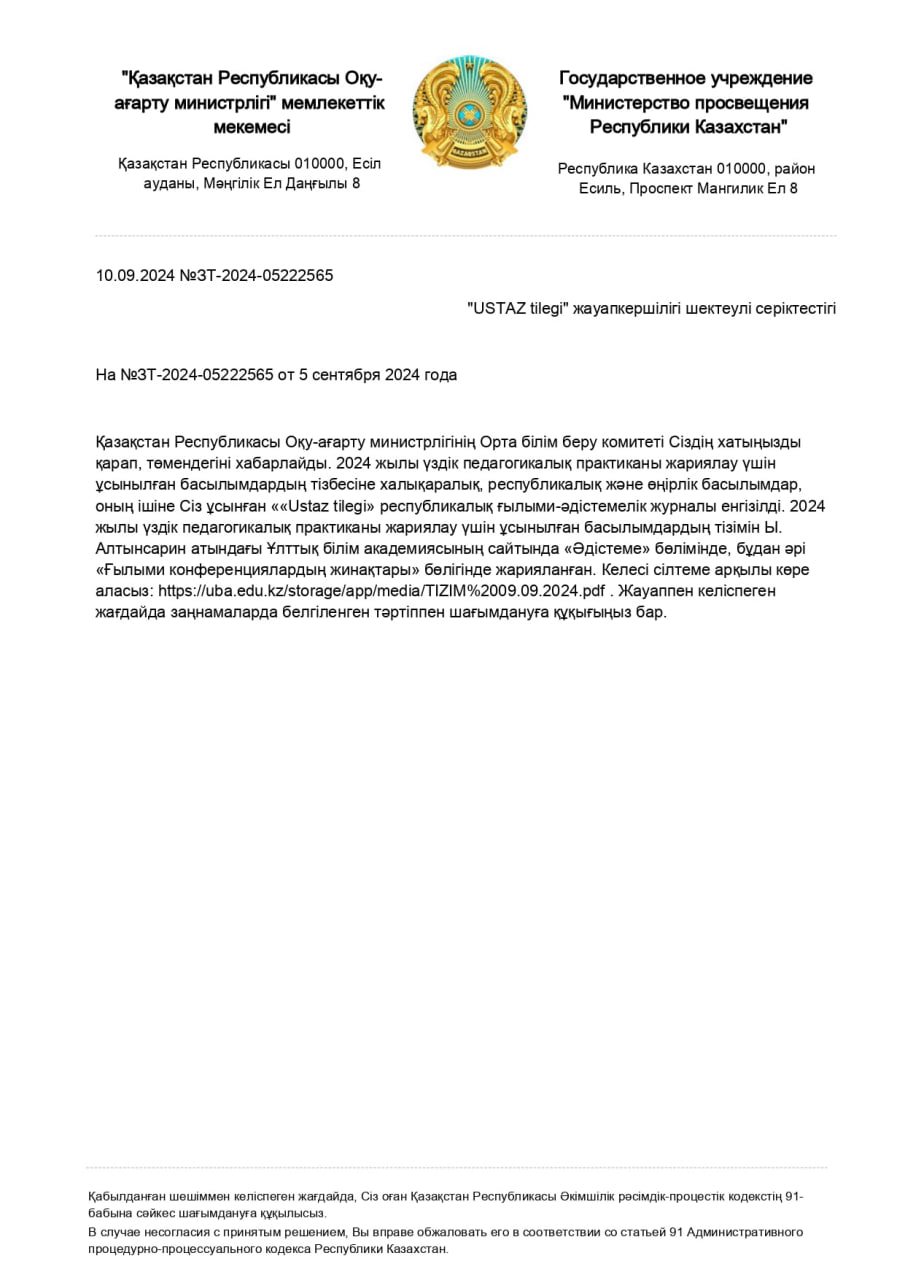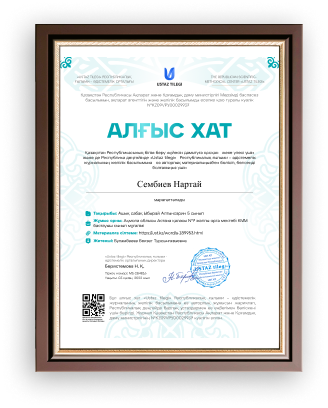
LESSON PLAN
|
Discipline |
«Foreign Language» (Social and Humanitarian Direction) |
||||||||||||||||||||||||||||||||||||||||||||||||||||||||||||||||||||||||||||||
|
Module/unit |
Module 9. Independent project |
||||||||||||||||||||||||||||||||||||||||||||||||||||||||||||||||||||||||||||||
|
Theme of the lesson |
Amazing places/ Simply unforgettable |
||||||||||||||||||||||||||||||||||||||||||||||||||||||||||||||||||||||||||||||
|
Teacher |
__________ Dzhumagulova Indira Mukhanovna |
Date: «27» December 2023 |
|||||||||||||||||||||||||||||||||||||||||||||||||||||||||||||||||||||||||||||
|
General information |
Course 1 Group EI 23-3 |
||||||||||||||||||||||||||||||||||||||||||||||||||||||||||||||||||||||||||||||
|
Type of the lesson |
Assimilation of new knowledge, combined lesson |
||||||||||||||||||||||||||||||||||||||||||||||||||||||||||||||||||||||||||||||
|
Lesson objectives |
1) Understand specific information in unsupported extended talk on a wide range of general and curricular topics, including talk on a limited range of unfamiliar topics; 2) Evaluate and comment on the views of others in a growing variety of talk contexts on a growing range of general and curricular topics; 3) explain and justify their own and others’ point of view on a range of general and curricular topics |
||||||||||||||||||||||||||||||||||||||||||||||||||||||||||||||||||||||||||||||
|
Assessment Criteria |
Learners will be able to:
|
||||||||||||||||||||||||||||||||||||||||||||||||||||||||||||||||||||||||||||||
|
Resources |
https://www.youtube.com/watch?v=wG7OGeMKQL0&t=13s https://youtu.be/7Wl4t1PgiSE?si=x5VeSXSwp0EcGdhP |
||||||||||||||||||||||||||||||||||||||||||||||||||||||||||||||||||||||||||||||
|
PROGRESS OF THE LESSON |
|||||||||||||||||||||||||||||||||||||||||||||||||||||||||||||||||||||||||||||||
|
Stages of the lesson |
Planned lesson activities |
Resources |
|||||||||||||||||||||||||||||||||||||||||||||||||||||||||||||||||||||||||||||
|
Start of the lesson (call stage) 20 min
|
Goal: creating a collaborative environment. The aim: To develop Ss speaking skills and create friendly atmosphere Efficiency: Ball game came from Chula. It seems a bit simple at first, but it’s not as easy as it appears. First, we need a ball. The first student holds the ball and asks a question like “How old is your boyfriend?” As the first girl is asking the question, she throw the ball to a friend who in turn must answer the question before touching the ball to catch it. Otherwise, if the friend hesitates for too long, or is too slow and hasn’t finished answering before she touches/catches the ball, then she is disqualified and must leave the circle and sit down. Then, next girl on her right takes the ball, and asks yet another question while throwing it to yet another girl, who in turn must answer before her hands touch the ball, and so on and so on, until there is only one girl/person left standing. Some sample questions might be What’s your mother’s age? How many children are there in your family? What is your favorite sport? What is your favorite color? Movie? Song ? Actor? What is your favorite gemstone? What Sport do you play best? How tall are you? How much do you weigh? What kind of movies do you like? Music? Car? Fast food What is the capitol of USA? II. Updating of prior knowledge Answers to homework questions Description of favorite book, genre or author Work in group. How would this story be different if it took place today? Think of: characters-place-plot. Present your idea to the class. |
Appendix 1
|
|||||||||||||||||||||||||||||||||||||||||||||||||||||||||||||||||||||||||||||
|
Mid-lesson (Comprehension stage) 55 min
|
I show the students the photos of the picturesque places. Students predict the topic of the lesson.
Leading questions: What do you think the main theme of today’s lesson will be? What factors do you think shape the way people live in different parts of the world? Begin with a brief discussion about the concept of different ways of living. Ask students to share their thoughts on what influences the way people live, considering cultural, geographical, and environmental factors.
Introduce
students to the topic and objectives of the
lesson. Dividing into groups Here I divide students into 3 groups by 1, 2, 3 numbers and direct Ss’ attention to the texts A-C and the words in the lists above each one, give Ss time to use the words to complete the texts. https://wordwall.net/ru/resource/65530127 Presenting new vocabulary.
Watch the video “People around the world” following the text in their book. CCQ -Low achievers answer YES/NO questions, high achievers 5 Ws and H questions Low achievers- Is the text A about Mongolia? Are they friendly? Are they happy to have guests? Are the clothes of the Maasai colorful? Do they like to wear necklace? Do the Atayal live in Taiwan? Are they hunters? High achievers 5 Ws and H questions What kind of people are Mongolians? Where is Mongolia situated? What kind of the clothes of the Maasai? What do the Atayal do? What don’t they like to do? How are the Atayal called? Use maps, flow charts, or webs to organize materials. (Find some additional information about these countries, their traditions, show them in the map) https://wordwall.net/ru/resource/62090933 Cognitive strategy Uses reading skills to highlight necessary information Differentiation method- They watch the video twice. Make some differences and similarities between these countries and traditions by Venn diagram like postures Find out similarities and differences between these countries
TPR method Explicit teaching of vocabulary. Teacher explains new words related to the topic using “Definitions” method. It’s a verbal explanation, giving synonyms, antonyms, or superordinate terms, giving a full definition. New words to learn: Check these words box and explain/elicit the meanings of the words or ask Ss to use their dictionaries and look them up 3Bows- weapons that shoot arrows 1Lean- without fat 2Curly- having curls 8Attached- liking very much 5Native- belonging to an area 7Gather- collect together 4Crops- food grown to eat 6Generous- giving things to others 3Wander- walk freely around an area What do the sentences in Ex 1 tell us about the Hadza? Why are they the last of the first? KWL chart stands for Know, Want to Know, Learned. They start by writing everything they know, everything they already know about a topic on the K column. Afterwards students list questions about what they want to know about the topic in the W column What do the sentences in Ex 1 tell us about the Hadza? Why are they the last of the first?
LISTENING Task 1.Pre – listening
This activity helps to develop critical thinking. Task 2. While listening
Skimming I demonstrate the video on the topic of “Hadza the last of the first”. Students watch the video and do some tasks.
Task 3. Post – listening 1. True or False Listening for detailed comprehension. Task for low motivated students. Tasks for high motivated students. Collaborative approach. Students talk about the peculiarities of Hadza tribe’s life. The students understand the main idea and demonstrate their ability to talk about based on the video. Low-achieving students scan the text and for each question, choose the correct answer to express their understanding. High-achieving students scan the text intensively to get as much information as possible. They answer commands such as: Identify the importance of living in the tribe. Circle three adjectives describing tribe. Underline the sentence about peculiarities of this tribe Describe their appereances. Explain why they chose this way of living.
ЖИ арқылы жасау
ЖИ арқылы жасау
Бөлісу 1 - айлық Материал тарифі-96% жеңілдік 00 05 00 ҚМЖ
Ашық сабақ
Тәрбие сағаты
Презентация
БЖБ, ТЖБ тесттер
Көрнекіліктер
Балабақшаға арнарлған құжаттар
Мақала, Эссе
Дидактикалық ойындар
және тағы басқа 400 000 материал
Барлық 400 000 материалдарды шексіз жүктеу мүмкіндігіне ие боласыз 1 990 ₸ 49 000₸ 1 айға қосылу Материалға шағымдану Бұл материал сайт қолданушысы жариялаған. Материалдың ішінде жазылған барлық ақпаратқа жауапкершілікті жариялаған қолданушы жауап береді. Ұстаз тілегі тек ақпаратты таратуға қолдау көрсетеді. Егер материал сіздің авторлық құқығыңызды бұзған болса немесе басқа да себептермен сайттан өшіру керек деп ойласаңыз осында жазыңыз Жариялаған: Джумагулова Индира МухановнаШағым жылдам қаралу үшін барынша толық ақпарат жіберіңіз Ашық сабақ Different ways of living
Тақырып бойынша 11 материал табылды
Ашық сабақ Different ways of livingМатериал туралы қысқаша түсінік
Монғолия, Тайвань және Африка тайпаларының өмір сүру әдет-ғұрыптарының ерекшеліктерін айта отырып, заманның дамуын негізге ала отырып, студенттердің мәдениетаралық құзіреттіліктерін дамыту.
Мәтіннің негізінде «Түрлі елдердің өмір сүру әдет-ғұрыптары/Хадза» тақырыптарында өз ойларын жеткізуді.
Материалдың қысқаша нұсқасы LESSON PLAN
| ||||||||||||||||||||||||||||||||||||||||||||||||||||||||||||||||||||||||||||||
















